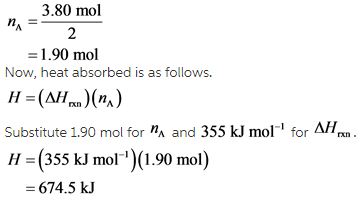(A) Calculate the standard enthalpy change for the reaction:
2A+B <===> 2C+2D
Use the following data:
Substance:
A (?H^f [kJ/mol] = -231)
B (-409)
C (217)
D (-475)
ANSWER: ?Hrxn= 355 kJ
(B) For the reaction given in Part A, how much heat is absorbed when 3.80 mol of A reacts?
Concepts and reason
The concept used to solve this problem is based on enthalpy change of a chemical reaction.
The enthalpy change is the difference of enthalpy of formation of products and reactants multiplied by their stoichiometric coefficient.
Fundamentals
The formula for enthalpy change is written as follows.
Answer:
Part A
The reaction is as follows.
Part A
The enthalpy change of the reaction is 355 kJ.
The enthalpy change is calculated by subtracting the enthalpy of formation of reactants from enthalpy of formation of products.
Part B
In the reaction,
![]()
Two moles of A reacted with one mole of B to give the products. Thus, 3.80 mol of A reacted is calculated by dividing 3.80 mol and 2.

Part B
The heat absorbed in the reaction is 674.5 kJ.
The heat absorbed in the reaction is calculated by multiplying the change in enthalpy and number of moles of substance reacted.

